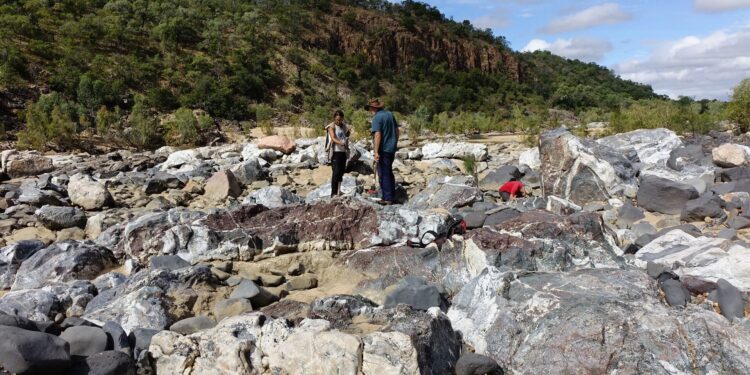Georgetown inlier researchers. Credit: Curtin University
The research led by New Curtin revealed that the water had played a much more important role than we thought previously in the formation of the first continents of the earth, by transforming the early crust of the planet and helping to build the masses that we see today.
In an article published in Earth & Environment CommunicationsThe research team studied rocks of $ 1.6 billion, the inlier of Georgetown, in the northeast of Queensland, to some of the best-preserved continental pieces on earth.
The main researcher, Dr. Silvia Volante, who finished research at Curtin’s School of Earth and Planetary Sciences, but is now based in Eth Zurich in Switzerland, said the results could redefine our understanding of the role of water in the early evolution of the earth and its importance in the shaping of the continents that we see today.
“At the beginning of our planet, volcanic rocks broke out on the bottom of the ocean and were then modified by hot water while they were cooling and solidified. Over time, these water -rich rocks were buried deeply in the earth’s crust, where the introduction of additional water caused them to partially melt at temperatures ranging from 700 ° C to 750 ° C Dr. Flying.
“By analyzing the oxygen levels in the rocks, the research team found a clear difference between the original volcanic rocks and the granite rocks that they have transformed – suggesting an additional source of water in the depths of the terrestrial coat.
“The two sources of water that have formed the continental crust rocks – one of the volcanic rocks themselves, and more surprisingly from the most deep of the earth – fueled a chain reaction of the fusion which lasted millions of years and helped to form the constituent elements of the continents on which we live today.”
Co-author Arc Laureat Fellow John Curtin, Professor Emeritus, Zheng Xiang Li, also from the Curtin land and planetary science school, said that the team was lucky to be able to study the ancient rocks of Australia, which offer a rare and well-preserved file in the way the land has formed.
“We had an incredible opportunity to work in unique places such as the Georgetown Inlier, which is one of the only places in the world where we can see all the stages of the formation of the continental crust enclosed in a rock of billions of dollars,” said Professor Li.
“Our next step is to determine whether similar water -based fusion processes have occurred in even older crust fragments. Finding more well -preserved examples will help show how the movement of crucial water in the Earth’s coat was shaping the early landscape of our planet.”
More information:
Silvia Volante et al, the displacements of the isotopes of oxygen reveal a fluid fusion in the continental anatexis, Earth & Environment Communications (2025). DOI: 10.1038 / S43247-025-02250-Z
Supplied by Curtin University
Quote: Ancient rocks reveal how water helped shape the world (2025, April 15) recovered on April 15, 2025
This document is subject to copyright. In addition to any fair program for private or research purposes, no part can be reproduced without written authorization. The content is provided only for information purposes.


